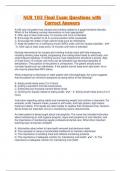Exam (elaborations)
NUR 103 Final Exam Questions with Correct Answers
- Course
- Institution
NUR 103 Final Exam Questions with Correct Answers NUR 103 Final Exam Questions with Correct Answers NUR 103 Final Exam Questions with Correct Answers NUR 103 Final Exam Questions with Correct Answers NUR 103 Final Exam Questions with Correct Answers NUR 103 Final Exam Questions with Correct Answers...
[Show more]



